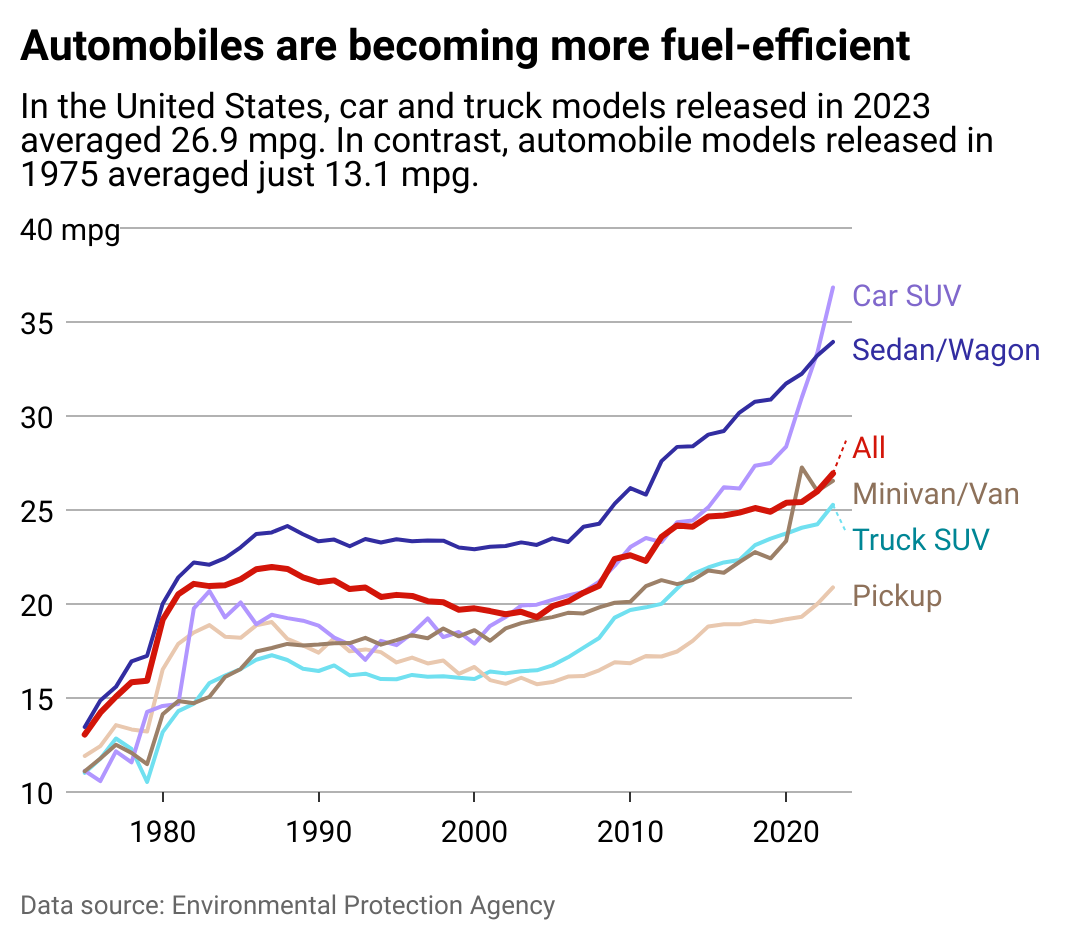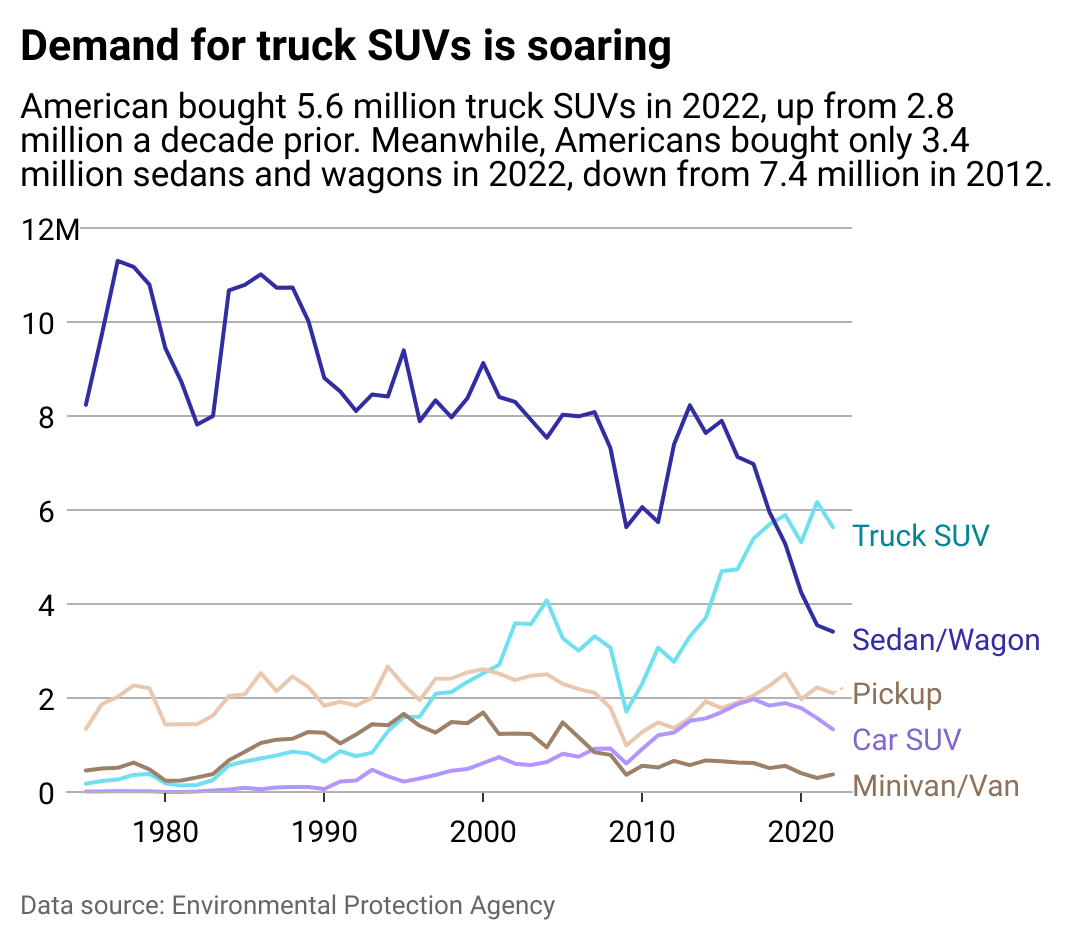Americans' love of trucks is offsetting overall vehicle efficiency gains
BoJack // Shutterstock
Americans’ love of trucks is offsetting overall vehicle efficiency gains
A row of parked trucks.
Pickup trucks are the vehicle of choice for many Americans. In 2023, five of the 10 most sold cars were pickup trucks made by Ford, Toyota, Ram, Chevrolet, and GMC.
Meanwhile, approximately 8 million new SUVs were sold in the U.S. in 2023, according to CarPro. First introduced in the American commercial market during the early 20th century, these vehicles were rugged, humble, no-frills machines often meant for rough terrain. They have evolved into large, luxury family vehicles with cutting-edge technology, impressive performance, and off-roading capabilities. One of the most popular types of vehicles in the U.S., this category includes truck SUVs, which are built on a truck-based frame, and car SUVs, which are sometimes called “crossovers” with unibody construction on a car-based frame.
Pickup trucks have become a status symbol for many Americans: an embodiment of strength, hard work, independence, and hardy individualism that characterize the American spirit. While buying used vehicles for other types of car models is cheaper, this is not the case with pickups, which have a high resale value that sometimes exceeds the price of a new truck.
Pickup trucks have gotten bigger over time, increasing the risk of pedestrian accidents. A 2023 report by the Insurance Institute for Highway Safety found that cars with hood heights exceeding 40 inches were 45% more likely to strike a pedestrian than a more compact vehicle.
Thanks to oil price shocks and government policy, car efficiency has more than doubled since the 1970s. However, since 2017, the growth in car efficiency has tapered off, with automakers Mazda, Honda, Subaru, Volkswagen, BMW, and GM selling vehicles in 2022 that were, on average, less efficient than their 2017 counterparts. Americans’ love for trucks—known as gas guzzlers for their fuel demands—has been responsible for dragging down efficiency gains.
The General used Environmental Protection Agency data to see how cars and trucks have become more efficient over time.
![]()

The General
Cars are becoming more fuel-efficient
A line chart showing cars in America becoming more fuel efficient over time. Automobile models got around 27 mpg in 2023, up from 13 mpg in 1975.
Up to the early 1970s, fuel economy was not a major selling point for car shoppers. Many vehicles during this era clocked around 12 miles per gallon at the turn of that decade. This all changed following the 1973 oil crisis when the Organization of Arab Petroleum Exporting Countries placed an embargo on the U.S. and any country supporting Israel.
The oil crisis exposed how vulnerable the U.S. was to oil market price shocks. Congress then passed the Energy Policy and Conservation Act of 1975, implementing the Corporate Average Fuel Economy standards, which set a target of 27.5 miles per gallon fuel economy by 1985 for new passenger cars.
The CAFE standards helped drive significant efficiency changes in the ’70s. The Energy Independence and Security Act of 2007 raised the target to 35 miles per gallon by 2020.
Today, concerns about the environment and greenhouse gas emissions have driven people toward electric vehicles, which enjoy 60% to 73% efficiency. Electric cars have carried a bulk of the efficiency gains in recent years. Car SUVs are the most efficient category of vehicles as of the 2020s, with the bulk of their efficiency gains coming from Tesla vehicles.

The General
Consumers are buying bigger vehicles
A line chart showing how different kinds of cars are selling. Demand for truck SUVs have skyrocketed since 2010, surpassing sedans and wagons.
The fall of gas prices between 2015 and 2022 brought back Americans’ love for SUVs and pickup trucks.
Trucks and SUVs also appeal to Americans because of their size and strength, which can equate to less damage in a collision when up against a smaller vehicle. Many SUVs also come with safety features such as driver-assist and inflatable seatbelts.
Bigger vehicles also bring practical benefits. Their large volume allows for more storage, which comes in handy for large families and long road trips. The high ground clearance allows these vehicles to go off-road into areas inaccessible to sedans.
Historically, light trucks and work trucks were subject to less stringent CAFE standards and exempt from the gas-guzzler tax. This became a motivating factor for manufacturers to not only make more trucks but also expand the definition of a truck to include what could also be considered a car: SUVs.
When discussing SUVs, it is essential to differentiate between truck SUVs and car SUVs. Truck SUVs are built on a truck-based chassis using body-on-frame construction, while car SUVs are built on a car-based platform, using unibody construction. Car SUVs or “crossovers” are less suited for off-roading than their truck-based counterparts. As of 2022, 71% of SUVs were truck SUVs, according to the EPA.

The General
Cars and trucks are emitting less CO2, too
A line chart showing carbon emissions per mile, falling over time, broken down by type of car. New sedans and wagons now emit around 250 grams of CO2 per mile driven, down from 660 in 1975.
Back in 2014, the Union of Concerned Scientists warned that about one-fifth of all greenhouse gas emissions in the U.S. came from cars and trucks, with emissions averaging 24 pounds of carbon dioxide per gallon of burned fuel. It pointed to solutions, including fuel-efficient vehicles and electric cars and trucks.
Between 2005 and 2020, the average fuel economy of light-duty vehicles grew from 20 miles per gallon to 25.7 miles per gallon. Trucks and SUVs significantly contribute to emissions because they are designed with utility and power in mind and are heavier than sedans and hatchbacks. As such, they release more carbon dioxide per traveled mile.
If the demand for SUVs and trucks had not increased, passenger vehicles would have consumed less fuel, resulting in lower emissions. If a fall in demand for SUVs and trucks accompanies a rise in demand for electric vehicles, efficiency gains can rise.
Story editing by Shannon Luders-Manuel. Copy editing by Kristen Wegrzyn.
This story originally appeared on The General and was produced and
distributed in partnership with Stacker Studio.






